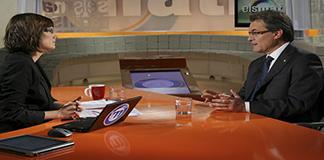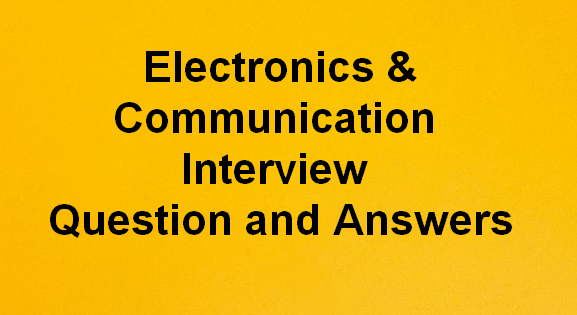Hey guys here we brought some Electronics Engineering (ECE) Interview Questions and Answers. It’s a very difficult to study all topics that’s why here we covered all subjects. These questions are asking most frequently during interview time. You can covered all subjects at very short period of time. We all know during interview time what’s the situation so be prepare in advance. There is a solution to every problem. Do not take tension just be prepare your self and make it more strong than you. If you do not have any idea about technical questions just take a look here i will share with you some technical interview questions and answers for freshers.
Electronics and Communication Engineering (ECE) Interview Questions and Answers
1.What is analog-to-digital conversion of signals?
A discrete-time signal is defined by specifying its value only at discrete times, called sampling instants. When the sampled values are quantized and encoded, a digital signal is obtained. A digital signal is obtained from the analog signal by using an analog-to-digital converter. This entire process is referred to as the conversion of signals from analog to digital form.
2.What are the properties of ROC for z-Transform?
Properties of the ROC for the z-Transform:
X(z) converges uniformly if and only if the ROC of the z-transform X(z) of the sequence includes the unit circle. The ROC of X(z) consists of a ring in the z-plane centered about the origin. That is, the ROC of the z-transform of x(n) has values of z for which x(n) r-n is absolutely assumable.
- The ROC does not contain any poles.
- When x(n) is of finite duration then the ROC is the entire z-plane, except possibly z=0 and/or z=infinity.
- If x (n) is a right sided sequence, the ROC will not include infinity.
- If x (n) is a left sided sequence, the ROC will not include z=0. However if x(n)=0 for all n>0, the ROC will include z=0.
- If x (n) is two sided and if the circle |z| = r0 is in the ROC, then the ROC will consist of a ring in the z-plane that includes the circle |z|=r0.
- If X (z) is rational, then the ROC extends to infinity, i.e. the ROC is bounded by poles.
- If x (n) is causal, then the ROC includes z=infinity.
- If x (n) is anti- causal, then the ROC includes z=0.
3.What are the functions of Base Station System (BSS)?
Functions of BSS are as follows:
- Radio path control.
- BTS and TC control.
- Connection establishment with MS-NSS.
- Mobility management, speech transcending.
- Connection of statistical data.
4.What are the parts of Network Management System (NMS)?
Following are the parts of network management system:
- OMC: Operation and maintenance center – Computerized monitoring center.
- NMC: Network Management Center – Centralized control of a network is done here.
- OSS: Operation and support system – Used for supporting activities performed in an OMC and/or NMC.
5.What are applications of DSP?
Some selected applications or digital signal processing that are often encountered in daily life are listed as follows:
- Telecommunication: Echo cancellation in telephone networks.
- Military Radar signal processing
- Consumer electronics Digital Audio/TV
- Instrumentation and control
- Image processing image representation, image compression
- Speech processing speech analysis methods are used in automatic speech recognition
- Medicine Medical diagnostic instrumentation such as computerized tomography (CT)
- Seismology DSP techniques are employed in geophysical exploration for oil and gas.
- Signal Filtering Removal of unwanted background noise.
6.What are the drawbacks of Walsh codes?
Walsh codes have the following drawbacks:
- The codes do not have a single, narrow auto correlation peak.
- The spreading is not over the whole bandwidth; instead the energy is spread over a number of discrete frequency components.
- Although the full sequence cross correlation is identically zero, this does not hold for a partial sequence cross correlation function. Thus advantage of using orthogonal codes is lost.
- Orthogonality is also affected by channel properties like multi path.
7. Explain radio environment in building.
- Building penetration: Building penetration depends on the material used for construction and architecture used. This varies building to building and is based on building construction.
- Building Height Effect: The signal strength is always higher at top floor and generally floor gain height is about 2.7dB/floor which is not dependent on building construction.
- Building Floor Reception: The signal isolation between floors in a multi floor building is on the average about 20dB. Within a floor of 150 * 150 feet, the propagation loss due to interior walls, depending on the wall materials is about 20 dB between the strong and the weak areas.
8. List some advantages of GSM.
Here are some advantages of GSM:
- GSM is mature; this maturity means a more stable network with robust features.
- Less signal deterioration inside buildings.
- Ability to use repeaters.
- Talk time is generally higher in GSM phones due to pulse nature of transmission.
- The availability of Subscriber Identity Modules allows users to switch networks and handset at will.
- GSM covers virtually all parts of world so international roaming is not a problem.
9. What are the various types of numbers for network identity?
Various types of number for network identity are as follows:
- MSISDN (Mobile station ISDN) Number: It is international mobile subscriber number which is normally called mobile number. It is unique worldwide.
- MSRN (Mobile Subscriber Routing Number) : MSRN is used during mobile terminate trunk call to provide location of mobile subscriber.
- HON (Hand Over Number) : HON is used for providing information required to transfer call from one B?SC to another BSC or to another MSC.
- ISMI (International Mobile Subscriber Identity Number) : Purpose of ISMI is for location update and authentication.
- TMSI (Temporary Mobile Subscriber Identity) : TMSI is used instead of IMSI to improve security efficiency of network.
- IMEI : International Mobile Equipment Identity.
10.What are GPRS services?
GPRS services are defined to fall in one of the two categories:
- PTP (Point to point)
- PTM (Point to Multi point)
Some of the GPRS services are not likely to be provided by network operators during early deployment of GPRS due in part to the phased development of standard. Market demand is another factor affecting the decision of operators regarding which services to offer first.
11.What are the advantages of CDMA?
Advantages of CDMA are as follows:
- Frequency diversity: Transmission is spread out over a large bandwidth due to that less affected by noise. If bandwidth is increased S/N ratio increases, which means noise will be reduced.
- Multiplication Resistance: Chipping codes used for CDMA not only exhibit low correlation but also low auto correlation. Hence a version of the signal that is delayed by more than one chip interval does not interfere with dominant signal as in other multi path environments.
- Privacy: Due to spread spectrum is obtained by the use of noise like signals, where each user has a unique code, so privacy is inherent.
- Graceful Degradation. In CDMA, more users access the system simultaneously as compared to FDMa, TDMA.
12.What are the advantages of spread spectrum?
Spread spectrum has the following advantages:
- No cross talk interference.
- Better voice quality/data integrity and less static noise.
- Lowered susceptibility to multi path fading.
- Inherent security.
- Co-existence.
- Longer operating distances.
- Hard to detect.
- Hard to intercept or demodulate.
- Harder to jam than narrow bands.
- Use of ranging and radar.
13. Explain the steps involved in demodulating a signal.
Once the signal is coded, modulated and then sent, the receiver must demodulate the signal. This is usually done in two steps: Spectrum spreading (e.g., direct sequence or frequency hopping) modulation is removed.The remaining information bearing signal is demodulated by multiplying with a local reference identical in structure and synchronized with received signal.
14. How can a Pseudo Random Noise Code be usable?
To be usable for direct sequence spreading, a PN code must meet the following conditions:
- Sequence must be built from 2 leveled numbers.
- The codes must have sharp auto correlation peak to enable code synchronization.
- Codes must have a low cross-correlation value, the lower it is, more are the number of users which can be allowed in the system.
- The codes should be “balanced” i.e. the difference between ones and zeros in code may only be one.
15.What are different categories of antenna and give an example of each?
Different categories of antenna are as follows:
- Wire Antennas – Short Dipole Antenna
- Micro strip Antennas – Rectangular Micro strip (Patch) Antennas
- Reflector Antennas – Corner Reflector
- Travelling Wave Antennas – Helical Antennas
- Aperture Antennas – Slot Antenna
- Other Antennas – NFC Antennas
16.What is handover and what are its types?
Handover in mobile communication refers to the process of transferring a call from one network cell to another without breaking the call. There are two types of handover which are as follows:
- Hard Handoff: hard handoff is the process in which the cell connection is disconnected from the previous cell before it is made with the new one.
- Soft Handoff: It is the process in which a new connection is established first before disconnecting the old one. It is thus more efficient and smart.
17. What is ionospheric bending?
When a radio wave travels into the ionospheric layer it experiences refraction due to difference in density. The density of ionospheric layer is rarer than the layer below which causes the radio wave to be bent away from the normal. Also the radio wave experiences a force from the ions in the ionospheric layer. If incident at the correct angle the radio wave is completely reflected back to the inner atmosphere due to total internal reflection. This phenomenon is called ionospheric reflection and is used in mobile communication for radio wave propagation also known as ionospheric bending of radio waves.
18.What is CDMA?
CDMA stands for Code Division Multiple Access which uses digital format. In CDMA systems several transmissions via the radio interface take place simultaneously on the same frequency bandwidth. User data is combined at the transmitter’s side with a code, then transmitted. On air, all transmission get mixed. At the receiver’s side the same code is used as in the transmitter’s side. The code helps the receiver to filter the user information of the transmitter from incoming mixture of all transmissions on the same frequency band and same time.
19.Explain the concept of frequency re-use.
The whole of the geographical area is divided into hexagonal shape geometrical area called cell and each cell having its own transceiver. Each BTS (cell site) allocated different band of frequency or different channel. Each BTS antenna is designed in such a way that i cover cell area in which it is placed with frequency allotted without interfering other sell signal.
20.Explain Bluetooth.
Bluetooth is designed to be a personal area network, where participating entities are mobile and require sporadic communication with others. It is Omni directional i.e. it does not have line of sight limitation like infra red does. Ericsson started the work on Bluetooth and named it after the Danish king Harold Bluetooth. Bluetooth operates in the 2.4 GHz area of spectrum and provides a range of 10 meters. It offers transfer speeds of around 720 Kbps.
These are the questions and answers for Electronics and communication engineering. I have covered all important topics. you can easily crack the interview. Now be prepared with these question and answer in interview.


